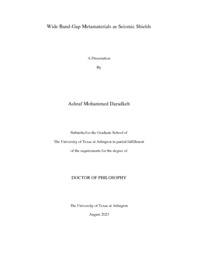| dc.description.abstract | In the past decade, a new paradigm gained popularity among researchers aiming to protect structures from low-frequency seismic vibrations using metamaterials. However, developing a workable design for metamaterials is still challenging, given the various factors such as material availability, size, and shape of its components. This project proposes a new configuration that can widen the attenuation frequency of metamaterials and evaluates the attenuation ability of double-graded metamaterials. The project investigates unit cell parameters such as but not limited to size, density, and modulus of elasticity to finalize a unit cell with the broadest possible bandgap by using common construction material such as concrete, steel, Carbon Fiber Reinforced Polymer (CFRP), and rubber. Moreover, the project investigates multi-layered unit cells with two, three, and four-layered metamaterials and evaluates its effects on the bandgap bounds.
Furthermore, the double-graded configuration is evaluated by modeling the real-world application of metamaterial, unit cells periodically embedded in soil medium and subjected to low-harmonic amplitude with low-frequency waves. The evaluation included both surface and body waves. Moreover, the configuration performance was evaluated for a Single Degrees of Freedom Structure (SDOF) by investigating the peak amplitude of the SDOF. Finally, the performance of double-graded metabarriers was assessed in the time domain in which the configuration is subjected to two artificial wavelets, Ormsby and Ricker, and a real-life seismic event from the records of El Centro earthquake, California 1940 (Peer Ground Motion). Moreover, a new double-graded configuration is presented to help reduce the SDOF peak frequency amplification. The result shows that a 4.5-15.3 Hz bandgap can be achieved using a 2 m two-layered unit cell made of rubber matrix and steel core.
Moreover, the upper bound of the attenuation zone can be increased up to 29 Hz by using the proposed configuration (double-graded configuration), and the lower bound can be decreased to 3.5 Hz, where the double-graded metabarriers can block 85% of the most destructive seismic frequencies. Furthermore, the double-graded configuration is shown to reduce the amplification of SDOF at the peak frequency, which is not located in the attenuation zone of the unit cell. Finally, the configuration is evaluated using a triangle-like double-graded design with fewer unit cells and more wave absorption. | |


